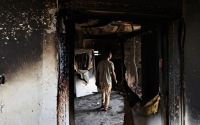The trend of northern lakes losing ice cover earlier each spring has accelerated during the past 30 years as scientists continue to document a warming climate.
Researchers recently re-examined ice trends for 56 lakes across Minnesota, Wisconsin, Michigan, Ontario and New York from 1971 to 2002. All 56 lakes showed a trend toward earlier ice-breakup dates — an average of three days earlier each decade.
The new study shows lakes losing their ice even faster than they were before 1975.
The study was headed by University of Wisconsin limnologist Barbara Benson and continues the research of a 2000 study that already showed lakes losing 18 days of ice cover from 1846 to 1995.
Dale Robertson, a U.S. Geological Survey research hydrologist who collaborated on the original ice research, said the new data is not surprising.
"It's not a step change. Freeze-up didn't move from November to January overnight. But it's clear freeze-up is getting later and ice-out is getting earlier,'' Robertson said. "And we know now that it's happening everywhere, not just in urban areas but all across the country and Canada and Europe.''
The new data was presented in August at the annual meeting of the Ecological Society of America in Montreal and could be published in Science Magazine early in 2006.
Also in Montreal, scientists and government officials from around the world are meeting this week for the United Nations Framework Convention on Climate Change as most of the world looks at serious efforts to reduce human-caused greenhouse gases.
LINE MOVING NORTH
In another example of the recent lake ice trend, Benson's researchers found the contour line on a map marking where lake ice has melted by April 7 each year moved north by 100 kilometers, or more than 62 miles, during the past 30 years.
The recent study reaffirms one released in 2000 that showed lakes across the U.S., Canada, Europe, Russia and Japan — over a 150-year period ending in 1995 — froze 8.7 days later in the fall and lost their ice 9.8 days earlier in the spring.
The lake ice study doesn't attempt to determine the cause of slowly climbing temperatures. But many scientists agree that burning fossil fuels — especially coal to generate electricity and gasoline to power vehicles — is contributing to an unprecedented, rapid rise in global temperatures that some say is actually changing our climate.
Critics of taking action to cut greenhouse gases, such as President Bush, say the cost of reducing pollutants like carbon dioxide will stifle the economy.
Some scientists say the documented warming is part of a natural cycle and is not being pushed by human-caused pollution. William M. Gray, Colorado State University professor of atmospheric science and a hurricane expert, believes temperatures are rising because Earth is coming out of "a little ice age'' in recent centuries and that the warming trend will end soon.
EVIDENCE MOUNTING
But many scientists who study the issue say that — like melting tundra in Alaska, disappearing glaciers in Greenland and rising sea levels worldwide — shorter winters of ice cover on northern lakes is yet another indicator of a long-term warming climate, likely because of human causes.
Other studies show northern Minnesota and Wisconsin frogs emerging from hibernation earlier and migrating songbirds returning north weeks earlier than they did just a few years ago.
Lucinda Johnson, a researcher at the University of Minnesota-Duluth's Natural Resources Research Institute, said climate change appears to be acting as one of many stressors on the environment, with many yet to be understood. Johnson's work focuses on amphibians, especially in prairie wetlands.
Premature reactions to spring can be a problem if insects haven't yet hatched for the birds to eat, for example, or if frogs are fooled into emerging earlier and then get caught if temperatures return to normal. That happened this spring and cut frog reproduction, Johnson said.
Increased sunlight and ultraviolet radiation also could play a role in the high level of frog deformities scientists are finding. And higher temperatures may be boosting parasites that can cause deformities in frogs. Johnson notes that changes in precipitation patterns, toward wetter winters and springs but drier summers — as predicted by global-warming proponents — may cause ponds and pools to dry up too soon for frogs to fully develop.
"Nothing surprises me any more with climate change. It's such a broad issue, like land use, that it's going to have so many effects,'' Johnson said.
Robertson said only one question remains unanswered.
"We know it's continuing. But, scientifically, we don't have a handle yet on whether this is natural climate variability or greenhouse gases,'' he said.
"Personally, I have my gut feeling on it. But, scientifically, we aren't there yet.''
Robertson spends much of his time plotting when Midwest rivers flood each spring, an annual ritual that also is happening weeks earlier as winter snow and river ice melt earlier.
"What used to happen in April is happening in March now. It's a month earlier,'' Robertson said.
Some say the cost of not acting now to stem higher temperatures will devastate the U.S. economy in future years.
J. Drake Hamilton, science and policy director for Minnesotans for an Energy-Efficient Economy, said more and more studies document a warmer climate in Minnesota, such as the ice cover research. She said the sensible reaction is to assume greenhouse gases are part of the problem and then move to a renewable-energy economy and away from imported fossil fuels.
"This issue has huge economic implications for our region. It's our lakes, our hunting grounds, our heritage all at risk here,'' Hamilton said. "Not acting will be much more costly for us.''
Hamilton will attend the conference in Montreal this week.
"Minnesotans are going to Montreal because we want to show the world that Washington is out of step with the American people,'' she said. "We also think Minnesota is in a perfect position to grow our economy as we lead the way to a renewable fuel economy. If we take action.''
Benson declined to comment on the details of the research until after it has been published in Science Magazine early next year. The News Tribune obtained the information from an abstract that Benson presented in August.
Study predicts peril for waterfowl region
The waterfowl-producing wetlands of Minnesota, Iowa and especially the Dakotas and Canada may be at high risk if climate warming trends continue, according to a scientist at South Dakota State University.
W. Carter Johnson, a professor of ecology, has conducted computer modeling that shows a marked reduction in wetlands and waterfowl.
Johnson's research appeared in the October issue of BioScience journal and was released by conservation groups in a report last week. Johnson's work is the first to examine the so-called prairie pothole region extensively.
Climate models predict that average temperatures will rise by 3 to 6 degrees Celsius over the next 100 years, devastating the western half of the prairie pothole region with more frequent drought, Johnson said. The prairie region produces between 50 percent and 80 percent of North America's ducks.
"We used pretty conservative estimates for warming — just 3 degrees. By 2050, the models show we'll lose half to two-thirds of the waterfowl-producing wetlands in the western prairie pothole area,'' Johnson said last week in a Duluth News Tribune interview. "The models show lesser effects in Minnesota and Iowa. But the problem is that most of the wetlands (in Minnesota and Iowa) already have been drained.''
— Duluth News Tribune
FOLLOWING UP ON KYOTO
Montreal is hosting the first-ever meeting of the Parties to the Kyoto Protocol starting this week and running through Dec. 9. More than 8,000 participants from 189 nations are expected to attend as most of the world tries to grapple with reducing human-caused greenhouse gases.
The United States, the largest contributor of such gases, is not participating officially, though representatives from Minnesota and other states will attend as members of nongovernmental organizations. Australia is the only other major nation not to have ratified the Kyoto treaty.
The treaty took effect in February and aims to cut global greenhouse-gas emissions to 5 percent below 1990 levels by 2012.
online
• For more information on global warming, go to the Minnesota Pollution Control Agency at www.pca.state.mn.us/hot/globalwarming.html.
• Learn more about groups opposed to taking action on global warming from the Competitive Enterprise Institute at www.cei.org/sections/subsection.cfm?section=3.






